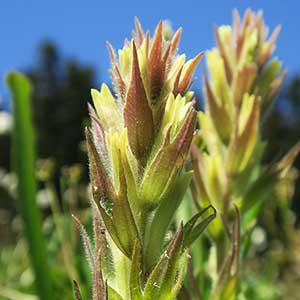Castilleja cryptantha
Castilleja ambigua
Mt. Rainier or obscure paintbrush, obscure Indian paintbrush, obscure paintbrush
estuarine paintbrush, johnny-nip, owl-clover paintbrush, paint-brush owl-clover, paintbrush, paintbrush owl's-clover
few to several, erect or ascending, unbranched, hairs spreading, long, soft, eglandular, mixed with short stipitate-glandular ones.
few to many, sometimes solitary (var. meadii), ascending or erect, often decumbent proximally, unbranched or branched above base, hairs sparse to moderately dense, spreading, long, soft, eglandular, mixed with short stipitate-glandular hairs.
green, often with brown or purple veins, narrowly to broadly lanceolate, 1.5–4 cm, not fleshy, margins plane, ± involute, 0–3-lobed, apex acute to acuminate;
lobes spreading-ascending, narrowly lanceolate, apex acute to ± obtuse.
green or brownish in upland forms, linear-lanceolate to widely lanceolate, linear, elliptic, obovate, or oblong, rarely ovate or cup-shaped, (0.6–)0.8–5 cm, fleshy or not, margins plane, flat, 3–5(–7)-lobed, apex rounded to obtuse or acuminate, abaxial surface often stipitate-glandular, adaxial sometimes shiny, glabrous;
lobes ascending to erect, linear to lanceolate, apex acute or obtuse.
(2.5–)3–6 × 1–2 cm; green to dull brown or dull reddish purple throughout, or proximally green to dull brown or dull reddish purple, distally yellow on apices, broadly lanceolate to ovate, (0–)3-lobed;
lobes ascending, narrowly lanceolate, long or short, arising near mid length, apex acute or acuminate.
1.5–9(–13) × 1–4 cm;
bracts proximally green, rarely brownish purple, distally white, cream, pink, or purple on apices, lanceolate, oblong, or ovate, (0–)3–5(–7)-lobed;
lobes ascending or divaricate-ascending, oblong to linear, short to long, arising below or above mid length, central lobe apex usually rounded to truncate, others acute to obtuse.
straight, 14–16 mm;
tube 11–14 mm;
whole corolla included within calyx;
beak adaxially pale yellow, 1–2 mm;
abaxial lip deep green, slightly inflated, 4–5 mm, 67% as long as beak;
teeth ascending, pale, 1.5–2 mm.
straight, 14–24 mm;
tube 11–21 mm, expanded distally;
abaxial lip and beak usually exserted, beak straight or slightly curved, adaxially white, yellow, or pink, sometimes green or purplish, (1–)4–7 mm, sparsely to densely short-hairy;
abaxial lip pale to bright yellow, sometimes becoming pink, orange, or red after anthesis, with red-brown or purple spots at base of each tooth and sometimes at base of each pouch, conspicuous, pouches 3, ± prominent, divergent, saccate, 2–7 × 3–7 mm, (33–)60–75(–90)% as long as beak;
teeth erect, sometimes spreading, white, pink, purple, or green, often with whitish bases, 1–3 mm.
proximally green or pale with green veins, lobes yellow, sometimes becoming deep red with age, 12–15 mm;
abaxial and adaxial clefts 3–7 mm, 25–50% of calyx length, deeper than laterals, lateral 1–3(–4) mm, 8–20% of calyx length;
lobes triangular, adaxial segments longer than abaxials, apex acute or obtuse.
green to pale yellowish green or tipped with white or purple, 8–23 mm;
abaxial and adaxial clefts 5–9 mm, 33–50(–67)% of calyx length, lateral 2–5.5 mm, 20–40% of calyx length;
lobes linear or narrowly lanceolate to oblong or ± triangular, apex acuminate or narrowly acute to obtuse or rounded.
glabrous.
= 24.
= 24.
Castilleja cryptantha
Castilleja ambigua
Castilleja cryptantha is endemic to the vicinity of Mt. Rainier in the Cascade Range, with most populations found within Mt. Rainier National Park. Unlike most species of Castilleja, it is apparently self-pollinating (W. J. Duffield 1972); the small flowers are entirely enclosed within the yellowish calyces, which tend to grow deep reddish as they age. The purplish brown bracts are also unusual in the genus.
(Discussion copyrighted by Flora of North America; reprinted with permission.)
Varieties 4 (4 in the flora).
Castilleja ambigua is a complex species, treated here with four varieties, though many localized variations exist among populations, and these are still incompletely understood.
(Discussion copyrighted by Flora of North America; reprinted with permission.)
1. Bract lobes linear; stems erect; moist inland meadows and vernal pools on volcanic substrates; c Napa County, California. | var. meadii |
1. Bract lobes linear to oblong; stems ± decumbent, at least proximally; coastal salt marshes, margins of brackish estuaries, coastal sandy bluffs, mesic to ± xeric inland grasslands; British Columbia to California. | → 2 |
2. Bracts pink to purple distally; stems unbranched or few-branched from mid stem; salt marshes; Humboldt Bay region, nw California. | var. humboldtiensis |
2. Bracts white distally, rarely pink or cream; stems often branched from base; salt marshes, sandy coastal bluffs, inland grasslands; British Columbia to California. | → 3 |
3. Corolla beaks usually white or yellow, abaxial lips yellow; salt marshes, sandy coastal bluffs, inland grasslands; s British Columbia to c California. | var. ambigua |
3. Corolla beaks usually pink to purplish, abaxial lips yellow, becoming white and then red or soft pink-purple; grassy coastal bluffs and adjacent sand dunes; vicinity of Monterey Bay, California. | var. insalutata |
- Local floras:
BC,
CA,
OR,
WA
- Local Web sites:
CalFlora,
CalPhotos,
Flora NW,
PNW Herbaria
WildflowerSearch
iNaturalist (observations)
USDA Plants Database
- LBJ Wildflower Center
- SEINet
- Plants of the World Online
- Encyclopedia of Life
- Wikipedia
- Google Image Search


